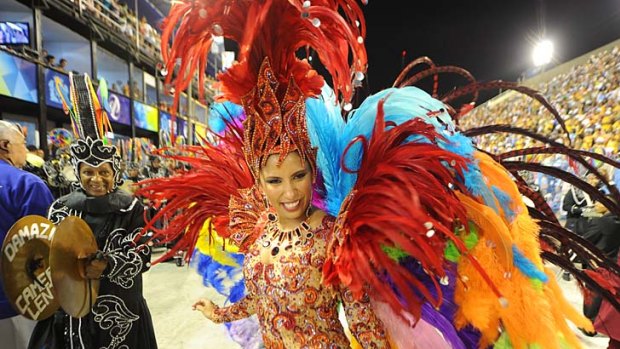Rio's Carnival celebrations were expected to reach their peak on Sunday in a riotous frenzy of skin, sweat, sequins and samba music that will culminate in the crowning of a new champion of the annual celebration.
Joyous street parties with copious beer consumption and a kaleidoscope of fantasy floats with sequin-clad women marked the start of the climax of the annual event late Sunday evening in Brazil, as eagerly-waited parades arrived in Rio's renovated Sambadrome -- also known as the "Temple of Samba."
Seven of the city's top samba schools will march allegorical floats and hundreds of lavishly costumed singers, dancers and musicians down a specially designed parade route to the Sambadrome.

A reveller of Renascer samba school warms up before parading at the Sambadrome in Rio de Janeiro.Credit: AFP
The first to parade will be the Renascer samba school from the western Rio de Janeiro district of Jacarepagua.
It will be making its first appearance in the elite group of 13 samba schools vying for the title of Carnival champion this year following its strong showing in 2011.
As a theme, Renascer chose to showcase the life and work of Brazilian artist Romero Britto, a Recife-born painter and sculptor viewed as an icon of world pop culture.
Six other schools are to parade Monday night as part of the hotly contested event to pick the Carnival champion, judged on choreography, music, dancing and creativity.
This racially diverse country of 191 million people has come to a standstill in the pre-Lent bacchanalian Carnival festival, Brazil's most popular holiday.
Preparation for the Sambadrome parades starts months in advance, as each samba school mobilizes thousands of supporters who must create the various parts of the school's display.
Those parades have a special meaning for residents of Rio's impoverished shanty towns, or favelas, for whom samba -- a dance which African slaves brought to this country -- stirs passions as strong as soccer.
Favela residents are often members of a local samba school and are deeply involved with the performance and preparation of costumes.
It turns the spotlight on the amazing artistic talent, creative genius and zest for life found in those predominantly black shantytowns which often lack running water, electricity and sewage systems.
The spectacular parades will take place in the renovated Sambadrome, originally designed 30 years ago by famed Brazilian architect Oscar Niemeyer.
The arena, which reopened last week after a nine-month makeover, now has a 72,500-seat capacity, elevators, and access ramps for the handicapped.
Sambadrome seats cost between $50 and several thousand dollars, depending on whether one sits on packed benches in the open or in air-conditioned VIP boxes stocked with champagne.
The Rio Carnival, billed as "the greatest show on Earth," generates 250,000 jobs and revenues of $US640 million for hotels, bars and restaurants, according to state estimates.
The cream of Brazil's society and its most famous stars will be at Sunday's Sambadrome events. Big-name companies invite luminaries, including foreign celebrities, to their Sambadrome skyboxes overlooking the processions to promote their brands.
Carnival is celebrated with equal gusto in other cities and towns, including Sao Paulo, Brazil's economic capital and Latin America's most populous city, and the northeastern city of Salvador, the heart of the rich Afro-Brazilian culture.
As in previous years, Salvador led the way, with hundreds of thousands of revelers pouring into the streets of Brazil's third largest city late Thursday.
The theme for this year's Carnival in Salvador is "The Carnival Country," the title of a 1931 novel by Jorge Amado, in homage to the late local author as the city marks the 100th anniversary of his birth.
Every year samba schools chooses a different theme for the parades, such as famous figures of Brazilian history, or paying tribute to the country's diverse racial and ethnic heritage.
The parading schools are divided into sections, and each section has a wing of about 100 people each wearing the same costume.
On Saturday, more than two million revellers -- many of them favela residents -- flooded central Rio for a mammoth street bash organized by Bola Preta, one of the oldest and most popular Carnival street bands.
Rio officials said they expect more than five million people, including 850,000 tourists, to enjoy the five-day festival which was opened by legendary Carnival King Momo on Friday.
AFP
Sign up for the Traveller Deals newsletter
Get exclusive travel deals delivered straight to your inbox. Sign up now.